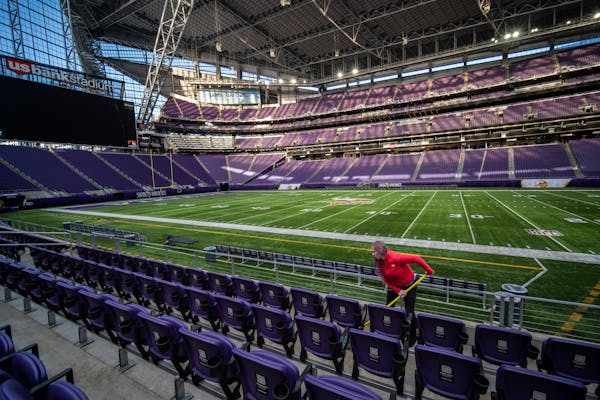Gov. Tim Walz's proposal to pay off the $1.1 billion U.S. Bank Stadium just seven years after it opened seems a near certainty given the warm reception it received at the Legislature.
In his budget proposal this week, Walz said he wants to pay off the $377 million in outstanding bond debt from the publicly financed portion of the stadium. He would use the balance in the stadium reserve fund — $368 million — as well as general fund money to make the final payment, which wasn't expected to occur until 2046.
"It just makes sense," Walz said at his budget news conference Tuesday.
The question unanswered by the Walz proposal, however, is what to do about an ongoing need to keep the stadium fresh. His budget wouldn't set up a dedicated maintenance fund for the building. Instead, Walz would redirect the money now flowing into the stadium reserve account from pulltab tax revenue to the state's general fund.
The Minnesota Sports Facilities Authority (MSFA), the public body that oversees the building on behalf of taxpayers, and the Minnesota Vikings say the stadium requires a permanent, dedicated fund to keep it in top-notch condition and that the state is obligated to provide it under the building's use agreement.
MSFA Chair Michael Vekich, a Walz appointee, said a core obligation of the authority is to maintain the stadium as a "state-of-the-art facility." While existing revenue, including annual payments from the Vikings, the state and Minneapolis, have met the needs so far, "they were not designed to cover more substantial maintenance and improvement needs as the stadium reaches 10, 20 and 30 years of operation," Vekich said.
Vikings Vice President Lester Bagley agreed, saying, "It is critical to now protect this community asset for the long term."
At its monthly meeting Thursday, the MSFA took a big step toward developing a timeline and price tag for upkeep. The MSFA agreed to spend more than half a million dollars to hire Kansas City-based stadium architects Populous to assess the building and create a maintenance plan. Populous is expected to provide an initial outline at the MSFA's Feb. 23 meeting.
As part of the 2012 legislation to build the stadium, the state legalized electronic pulltabs. Tax revenue from electronic and paper pulltabs was directed into a reserve fund created to make payments on the nearly $500 million in state-issued bonds for the building. The state was expected to cover $349 million, with Minneapolis shouldering $150 million.
The state makes annual payments of about $30 million on the debt, including $12 million in debt service that comes from Minneapolis hospitality taxes.
If the Legislature agrees to pay off the stadium and abolish the reserve fund as Walz wants, the general fund will receive a net benefit of $772 million in the next two-year budget cycle from pulltabs.
The idea of paying off the stadium early didn't originate with the governor. Recently retired Sens. Tom Bakk, an independent from Cook, and Julie Rosen, R-Fairmount, favored an early payoff.
Current Senate leaders also support the idea.
"Our caucus was very much on board on getting that done last year and we're glad the governor is on board now," said Senate Minority Leader Mark Johnson, R-East Grand Forks.
Assistant Senate Majority Leader Nick Frentz, DFL-North Mankato, called the early payoff a positive step. "Minnesotans like the idea of paying off debt, and they like the stadium. The stadium's phenomenal," Frentz said.
Johnson and Frentz also agree on the need for a maintenance account with dedicated funding.
The stadium's "going to be around a long time, and there's a contractual obligation we have as a state to keep it in a first-class condition," Frentz said.
Johnson likes the idea of devoting a portion of the pulltab revenue to that purpose. "I just want to make sure that the long-term viability of the stadium is there," Johnson said. "If there's another alternative plan, I'm open to seeing what the details are."
The Walz plan would also spend $15.7 million for the first phase of the building's secure perimeter, a payment that would "mitigate a significant capital cost" to the MSFA, he said.
The MSFA has yet to reveal a perimeter design. The first phase of the project covers everything but the western side of the building that faces downtown Minneapolis and serves as the primary entry for most visitors. The perimeter project would be the largest upgrade since the building opened in August 2016 and is expected to include a restyling of club spaces and creation of a training area for event-day staff.
The governor's budget is just the starting point for legislative discussions, but Frentz is optimistic about Walz's stadium proposals. "I don't know of anybody who doesn't think the security fence is a need, and I haven't run into anybody who says, 'Don't pay off the stadium and save us the interest,' " he said.
